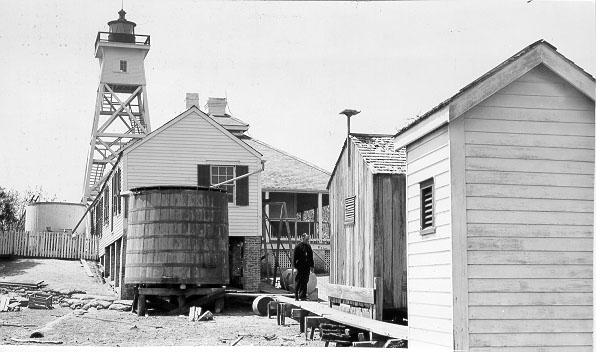|
Westwego
Westwego is a city in the U.S. state of Louisiana, located in Jefferson Parish. It is a suburban community of New Orleans in the Greater New Orleans metropolitan area and lies along the west bank of the Mississippi River. The population of the city of Westwego was 8,568 at the 2020 United States census. Etymology One story states that Westwego was so named because it was a major crossing point on the Mississippi River during the great westward movement of the late 19th century. When travelers were asked their destination, they would often reply "west we go". Another more specific tale, recounted in John Churchill Chase's ''Frenchmen, Desire, Good Children'' is that the name was the specific outcome of an 1871 meeting of a railroad board of directors in New York, where planning was undertaken to use the site as an eastern terminus ("...west we go from there"). There has been further speculation that this use of "Westwego" as a place name may have been influenced by the board ... [...More Info...] [...Related Items...] OR: [Wikipedia] [Google] [Baidu] |
Jefferson Parish, Louisiana
Jefferson Parish (french: Paroisse de Jefferson; es, Parroquia de Jefferson) is a parish in the U.S. state of Louisiana. As of the 2020 census, the population was 440,781. Its parish seat is Gretna, its largest community is Metairie, and its largest incorporated city is Kenner. Jefferson Parish is included in the Greater New Orleans area. History 1825 to 1940 Jefferson Parish was named in honor of U.S. President Thomas Jefferson of Virginia when the parish was established by the Louisiana Legislature on February 11, 1825, a year before Jefferson died. A bronze statue of Jefferson stands at the entrance of the General Government Complex on Derbigny Street in Gretna. The parish seat was in the city of Lafayette, until that area was annexed by New Orleans in 1852. In that year the parish government moved to Carrollton, where it remained for twenty-two years. Originally, this parish was larger than it is today, running from Felicity Street in New Orleans to the St. Charles P ... [...More Info...] [...Related Items...] OR: [Wikipedia] [Google] [Baidu] |
New Orleans Metropolitan Area
The New Orleans metropolitan area, designated the New Orleans–Metairie metropolitan statistical area by the U.S. Office of Management and Budget, or simply Greater New Orleans (french: Grande Nouvelle-Orléans, es, Gran Nueva Orleans), is a metropolitan statistical area designated by the United States Census Bureau encompassing eight Louisiana parishes—the equivalent of counties in other U.S. states—centered on the city of New Orleans. The population of Greater New Orleans was 1,271,845 in 2020, up from 1,189,166 at the 2010 United States census. According to 2017 census estimates, the broader New Orleans–Metairie–Hammond combined statistical area (CSA) had a population of 1,510,562. The New Orleans metropolitan area was hit by Hurricane Katrina—once a category 5 hurricane, but a category 3 storm at landfall—on August 29, 2005. Within the city of New Orleans proper, multiple breaches and structural failures occurred in the system of levees and flood walls designed ... [...More Info...] [...Related Items...] OR: [Wikipedia] [Google] [Baidu] |
Dust Explosion
A dust explosion is the rapid combustion of fine particles suspended in the air within an enclosed location. Dust explosions can occur where any dispersed powdered combustible material is present in high-enough concentrations in the atmosphere or other oxidizing gaseous medium, such as pure oxygen. In cases when fuel plays the role of a combustible material, the explosion is known as a fuel-air explosion. Dust explosions are a frequent hazard in coal mines, grain elevators, and other industrial environments. They are also commonly used by special effects artists, filmmakers, and pyrotechnicians, given their spectacular appearance and ability to be safely contained under certain carefully controlled conditions. Thermobaric weapons exploit this principle by rapidly saturating an area with an easily combustible material and then igniting it to produce explosive force. These weapons are the most powerful non-nuclear weapons in existence. Terminology If rapid combustion occurs in a ... [...More Info...] [...Related Items...] OR: [Wikipedia] [Google] [Baidu] |
City
A city is a human settlement of notable size.Goodall, B. (1987) ''The Penguin Dictionary of Human Geography''. London: Penguin.Kuper, A. and Kuper, J., eds (1996) ''The Social Science Encyclopedia''. 2nd edition. London: Routledge. It can be defined as a permanent and densely settled place with administratively defined boundaries whose members work primarily on non-agricultural tasks. Cities generally have extensive systems for housing, transportation, sanitation, utilities, land use, production of goods, and communication. Their density facilitates interaction between people, government organisations and businesses, sometimes benefiting different parties in the process, such as improving efficiency of goods and service distribution. Historically, city-dwellers have been a small proportion of humanity overall, but following two centuries of unprecedented and rapid urbanization, more than half of the world population now lives in cities, which has had profound consequences for g ... [...More Info...] [...Related Items...] OR: [Wikipedia] [Google] [Baidu] |
Marriage
Marriage, also called matrimony or wedlock, is a culturally and often legally recognized union between people called spouses. It establishes rights and obligations between them, as well as between them and their children, and between them and their in-laws. It is considered a cultural universal, but the definition of marriage varies between cultures and religions, and over time. Typically, it is an institution in which interpersonal relationships, usually sexual, are acknowledged or sanctioned. In some cultures, marriage is recommended or considered to be compulsory before pursuing any sexual activity. A marriage ceremony is called a wedding. Individuals may marry for several reasons, including legal, social, libidinal, emotional, financial, spiritual, and religious purposes. Whom they marry may be influenced by gender, socially determined rules of incest, prescriptive marriage rules, parental choice, and individual desire. In some areas of the world, arrang ... [...More Info...] [...Related Items...] OR: [Wikipedia] [Google] [Baidu] |
2010 United States Census
The United States census of 2010 was the twenty-third United States national census. National Census Day, the reference day used for the census, was April 1, 2010. The census was taken via mail-in citizen self-reporting, with enumerators serving to spot-check randomly selected neighborhoods and communities. As part of a drive to increase the count's accuracy, 635,000 temporary enumerators were hired. The population of the United States was counted as 308,745,538, a 9.7% increase from the 2000 census. This was the first census in which all states recorded a population of over half a million people as well as the first in which all 100 largest cities recorded populations of over 200,000. Introduction As required by the United States Constitution, the U.S. census has been conducted every 10 years since 1790. The 2000 U.S. census was the previous census completed. Participation in the U.S. census is required by law of persons living in the United States in Title 13 of the United ... [...More Info...] [...Related Items...] OR: [Wikipedia] [Google] [Baidu] |
Latino (U
Latino or Latinos most often refers to: * Latino (demonym), a term used in the United States for people with cultural ties to Latin America * Hispanic and Latino Americans in the United States * The people or cultures of Latin America; ** Latin Americans Latino and Latinos may also refer to: Language and linguistics * ''il Latino, la lingua Latina''; in English known as Latin * ''Latino sine flexione'', a constructed language * The native name of the Mozarabic language * A historical name for the Judeo-Italian languages Media and entertainment Music * ''Latino'' (Sebastian Santa Maria album) *''Latino'', album by Milos Karadaglic *"Latino", winning song from Spain in the OTI Festival, 1981 Other media * ''Latino'' (film), from 1985 * ''Latinos'' (newspaper series) People Given name * Latino Galasso, Italian rower * Latino Latini, Italian scholar and humanist of the Renaissance * Latino Malabranca Orsini, Italian cardinal * Latino Orsini, Italian cardinal Other names * ... [...More Info...] [...Related Items...] OR: [Wikipedia] [Google] [Baidu] |
Hispanic (U
The term ''Hispanic'' ( es, hispano) refers to people, cultures, or countries related to Spain, the Spanish language, or Hispanidad. The term commonly applies to countries with a cultural and historical link to Spain and to viceroyalties formerly part of the Spanish Empire following the Spanish colonization of the Americas, parts of the Asia-Pacific region and Africa. Outside of Spain, the Spanish language is a predominant or official language in the countries of Hispanic America and Equatorial Guinea. Further, the cultures of these countries were influenced by Spain to different degrees, combined with the local pre-Hispanic culture or other foreign influences. Former Spanish colonies elsewhere, namely the Spanish East Indies (the Philippines, Marianas, etc.) and Spanish Sahara (Western Sahara), were also influenced by Spanish culture, however Spanish is not a predominant language in these regions. Hispanic culture is a set of customs, traditions, beliefs, and art forms (mus ... [...More Info...] [...Related Items...] OR: [Wikipedia] [Google] [Baidu] |
Race (United States Census)
Race and ethnicity in the United States census, defined by the federal Office of Management and Budget (OMB) and the United States Census Bureau, are the Self-concept, self-identified categories of Race and ethnicity in the United States, race or races and ethnicity chosen by residents, with which they most closely identify, and indicate whether they are of Hispanic or Latino (demonym), Latino origin (the only Race and ethnicity in the United States, categories for ethnicity). The racial categories represent a social-political construct for the race or races that respondents consider themselves to be and, "generally reflect a social definition of race recognized in this country." OMB defines the concept of race as outlined for the U.S. census as not "scientific or anthropological" and takes into account "social and cultural characteristics as well as ancestry", using "appropriate scientific methodologies" that are not "primarily biological or genetic in reference." The race cat ... [...More Info...] [...Related Items...] OR: [Wikipedia] [Google] [Baidu] |
Pacific Islander (U
Pacific Islanders, Pasifika, Pasefika, or rarely Pacificers are the peoples of the Pacific Islands. As an ethnic/racial term, it is used to describe the original peoples—inhabitants and diasporas—of any of the three major subregions of Oceania (Melanesia, Micronesia, and Polynesia). Melanesians include the Fijians (Fiji), Kanaks ( New Caledonia), Ni-Vanuatu (Vanuatu), Papua New Guineans (Papua New Guinea), Solomon Islanders (Solomon Islands), and West Papuans (Indonesia's West Papua). Micronesians include the Carolinians (Northern Mariana Islands), Chamorros (Guam), Chuukese ( Chuuk), I-Kiribati (Kiribati), Kosraeans (Kosrae), Marshallese (Marshall Islands), Palauans (Palau), Pohnpeians ( Pohnpei), and Yapese (Yap). Polynesians include the New Zealand Māori (New Zealand), Native Hawaiians (Hawaii), Rapa Nui (Easter Island), Samoans (Samoa and American Samoa), Tahitians (Tahiti), Tokelauans (Tokelau), Niueans (Niue), Cook Islands Māori (Cook Islands) and Tonga ... [...More Info...] [...Related Items...] OR: [Wikipedia] [Google] [Baidu] |
Asian (U
{{disambiguation ...
Asian may refer to: * Items from or related to the continent of Asia: ** Asian people, people in or descending from Asia ** Asian culture, the culture of the people from Asia ** Asian cuisine, food based on the style of food of the people from Asia ** Asian (cat), a cat breed similar to the Burmese but in a range of different coat colors and patterns * Asii (also Asiani), a historic Central Asian ethnic group mentioned in Roman-era writings * Asian option, a type of option contract in finance * Asyan, a village in Iran See also * * * East Asia * South Asia * Southeast Asia * Asiatic (other) Asiatic refers to something related to Asia. Asiatic may also refer to: * Asiatic style, a term in ancient stylistic criticism associated with Greek writers of Asia Minor * In the context of Ancient Egypt, beyond the borders of Egypt and the cont ... [...More Info...] [...Related Items...] OR: [Wikipedia] [Google] [Baidu] |






